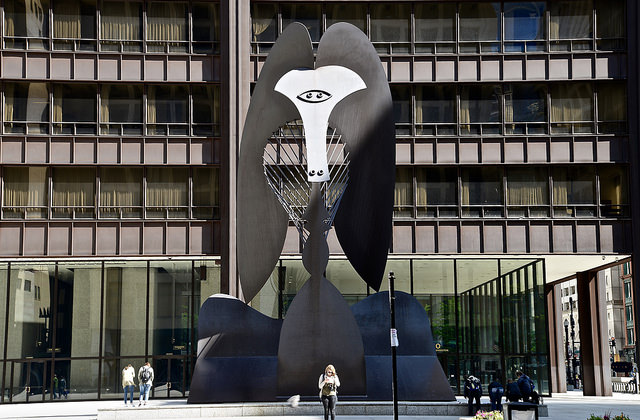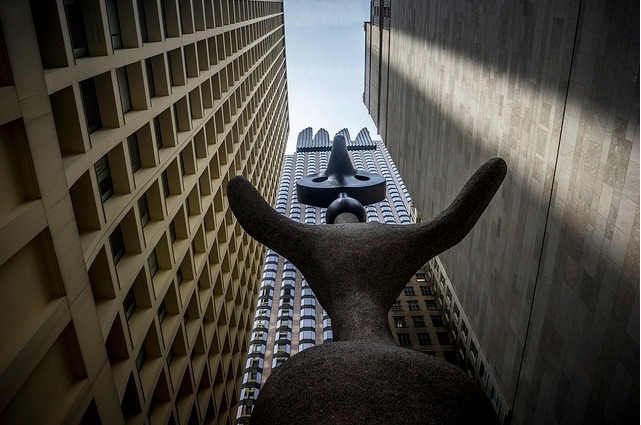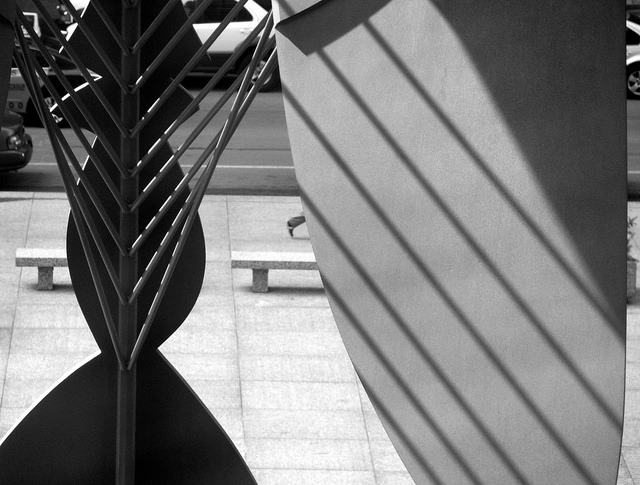How Daley Plaza's Picasso Sculpture Changed Chicago Public Art
By Chicagoist_Guest in Arts & Entertainment on Aug 3, 2016 3:00PM
By Corrie Thompson
If you wander through Daley Plaza this summer, you won’t miss the 50-foot statue of… something. No one has ever been sure what this monumental Picasso piece represents; in fact, when the city first received it in August of 1967, then Mayor Richard Daley dedicated it “with the belief that what is strange to us today will be familiar tomorrow.” This has indeed been the narrative of the nameless, controversial sculpture, which has not just become dear to the city but also majorly changed Chicago’s public art scene.
In 1967, The Picasso Was Plain Bizarre
But we got it for free!
Everything about the Picasso was oddball when it was made, including how it was commissioned and built. The Daley Center architects proposed the project to Picasso in the unlikely form of a poem, according to Statue Stories Chicago. No one knows exactly why, but he did accept the project. Picasso even turned down $100,000 in payment, preferring to present the statue as a gift to Chicago, a city he never visited in his lifetime. (Perhaps part of his motivation was to demonstrate his appreciation to the Art Institute of Chicago, the first museum in America to show his work.) Picasso’s final 162-ton sculpture was made of the same intentionally rusty steel as the Daley Center itself, and was built by U.S. Steel in Gary, Indiana. WTTW reported that the engineers “had to roll steel to sizes which never [had] been rolled," to accommodate the sculpture’s scale.
Also oddball: No one knew what it was a sculpture of. The Picasso is called that—“The Picasso”—because the artist didn’t name or explain the statue when he gave it to the city, according to the Daley Center. The city has been in disagreement about what the statue is since day one, and there’s really no wrong answer. Many say the sculpture is some kind of winged animal, or maybe an Afghan hound, since Picasso owned the latter. I’m in the camp that thinks of it as a baboon. Some insist it’s really a woman looking over her shoulder, and it only shows when the sculpture is viewed from the back. Regardless of which way she’s facing, Chicago Architecture Info argues the woman hypothesis is likely the most true, with the statue based on one of the artist’s frequent models who had a long neck and ponytail, an argument supported by a sketch from just after Picasso took on the commission.
Prior to The Picasso, public sculptures in Chicago had mainly portrayed important figures and historic events. Lorado Taft’s Heald Square Monument (1941), for instance, depicts the main players of the American Revolution. The Spearman and The Bowman, two statues of Native Americans, guard the entrance to Grant Park, and were somewhat tactlessly intended to commemorate the city’s pioneer days. The Picasso was such a departure from what had come before that it was “greeted at first with catcalls, scorn and ridicule,” according to Picasso’s website. Some people flat out wanted it removed; one disgruntled alderman called for a statue of beloved Cubs star Ernie Banks in place of the Picasso, the Chicago Tribune noted. (Somewhat ironically, a statue of Banks was temporarily placed in Daley Plaza years later, to commemorate his death.)
In 2016, It Fits Right In—Because It Made Modernism Mainstream
With some help from other artists, of course.
Luckily, rather than replacing the sculpture with something more decipherable, the city began to embrace the Picasso and contemporary art. Soon after the Picasso’s installation, the city received a flood of similar new pieces. Picasso was promised that a piece by an equally famous artist would be put up to accompany his work in Daley Plaza, the New York Times reports. This piece was Joan Miro’s The Sun, The Moon and One Star, which now faces the Picasso from across Washington Street. It was originally slated for installation in 1967, too, but funding difficulties pushed back its unveiling to 1981. Other modern artists’ work soon infiltrated Chicago’s streets. Chagall’s Four Seasons mosaic and Calder’s giant red lexander-calder">Flamingo “stabile” (as opposed to “mobile”) were both installed in 1974. They were followed in 1977 by Oldenburg's Batcolumn, a massive steel baseball bat standing in front of the Social Security Administration. DeBuffet’s graphic black-and-white Monument with Standing Beast arrived outside of the Thompson Center in 1984.
Many credit this public art renaissance to the Picasso, but there are some frequently overlooked factors that helped transform Chicago into a home for progressive art. Many know that the Pop Art and Abstract Expressionism movements were thriving by the ‘60s, but their lesser-known cousins developed in Chicago around the same time, in three groups of artists known as The Imagists, The Hairy Who, and their precursor, the Monster Roster. They helped pave the way for the Picasso, which was installed the same year Chicago got its first major mural: The Wall of Respect by artist William Walker and the Organization of Black American Culture, which prompted an entire mural movement that continues today. The Museum of Contemporary Art also opened within months of the Picasso, and hosted progressive shows of local, national, and international artists. In 1969, for instance, the MCA was the first public building in the United States to be entirely wrapped in fabric by the artist-duo Christo and Jean-Claude.
The Picasso was the well-timed public face of a unique contemporary art movement that was well under way in Chicago in the ‘60s. The winged-beast-woman in the Loop bred familiarity with and pride in Chicago’s already-burgeoning public art scene, helping to jumpstart an exemplary public art culture in the city. It’s still going strong today, as evidenced by Cloudgate (a.k.a. the Bean), Crown Fountain, Tony Tasset’s weird temporarily-installed eyeball sculpture and his Artist Monument in Grant Park this summer, and even pop-up galleries we see in the Loop. So next time you’re in Daley Plaza, take a minute to appreciate whatever it is that you think Picasso gave us, knowing that there’s more to it than meets the eye.
Corrie Thompson is a visual artist figuring out the post-grad life in Humboldt Park with her husband and toddler.


